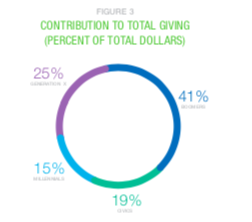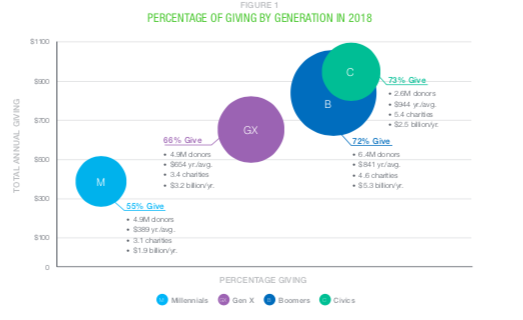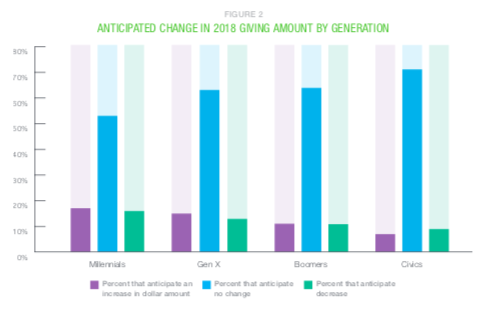- Home
- About Us
- The Team / Contact Us
- Books and Resources
- Privacy Policy
- Nonprofit Employer of Choice Award

 Generational change influences decisions that are made on a daily basis. Things like eating habits, the company people keep, exercise regimes and style choices are all results of generational differences—and philanthropic decisions are no exception. In a society that is so diversified by age groups, how can organizations establish strong and impactful relationships with a diverse supporter base? The most recent version of Canadian giving research offers these insights.
Generational change influences decisions that are made on a daily basis. Things like eating habits, the company people keep, exercise regimes and style choices are all results of generational differences—and philanthropic decisions are no exception. In a society that is so diversified by age groups, how can organizations establish strong and impactful relationships with a diverse supporter base? The most recent version of Canadian giving research offers these insights.
1 The Greatest Generation is in its sunset years.
Those born before 1946 are now in their mid-70s and up— remain a significant giving force, but their star is fading. In 2010, this generation dominated the philanthropic landscape. Today, the Civics have fallen behind Boomers and Generation X in terms of total dollars donated. While declining in numbers, however, they remain mighty in generosity. Civics donate more money per capita ($944) than any other cohort, and they give to more charities. It’s also worth noting that the current philanthropy infrastructure, along with its best practices, strategies and methods, was built for this generation. As new generations become dominant among givers, it is increasingly important to reconsider whether the founding assumptions that gave rise to philanthropy as we know it still hold.
2 Baby Boomers remain the most generous generation.
For those who are waiting for the ascendancy of Baby Boomer donors to pass from the scene, the wait is going to take a while. Boomers say they gave nearly $5.3 billion to charities last year. That represents 41% of all money donated during that period—an increase from 2013 when they represented 32% of all giving. Not only have Boomers given the most, but they are also more likely to be givers than younger generations. And, nearly three-fourths of Boomer donors say their giving will either stay the same next year (64%) or increase (11%). There is some early indication that Boomer-dominated giving may be approaching the top of the parabola.

3 Generation X continues to be on deck.
Gen-Xers may be approaching their prime giving years. This report finds that in 2018, 66% of Gen-Xers gave, and they contribute $3.2 billion per year. This makes up 25% of total giving in 2018. And, more than 15% of Gen-Xers say they expect to increase their giving in the coming year, almost twice as many as Civics (7% of which say their giving will increase) and more than Boomers (11%). This means the "Age of X" in philanthropy may be on its way. The numbers carry an important message for fundraisers. In the foreseeable future, your organization's financial well- being lies primarily with Boomers and Gen-Xers. This is not to suggest that Millennials should be ignored, but the case can be made that many pay them more heed right now than is prudent.

4 Millennial giving is still a work in progress.
Millennials contributed 15% of all money donated over the past year (Figure 3). That represents no change from 2013, when they also made up 15% of total giving. Only 17% of those Millennials who give say they plan to increase their giving in the next year. Millennial giving raises the discussion of how both life stage and permanent generational values affect giving. Historically, most giving has come from people middle aged or older. There’s a practical reason for that. The demands of building a career and raising a family often leave little room, or disposable income, for philanthropy. Millennials are not only at a life stage dominated by career and family priorities; they have inherited a world of economic uncertainty in which nothing can be taken for granted. There’s no question the day will come when Millennials are a philanthropic force to be reckoned with. That day, however, is far from imminent.
5 Channel proliferation continues, confounding strategy and attribution.
Giving is distributed across more channels than ever. The data suggests that while direct mail has declined and the number of people who say they responded to an email has remained steady, newer channels may not be picking up the slack. There is some speculation that the proliferation of giving channels may be causing "choice anxiety": the tendency to do nothing when confronted with too many options. That could be influencing the overall decline in giving behaviour. And, as this study shows, the digital environment is important to even late adopters. It should be a part of their engagement and cultivation, even in the twilight of their giving lives.
6 Concern about overhead remains high.
In spite of its shortcomings, one metric of choice for many donors continues to be the percentage of donated funds that go to programs as opposed to fundraising or administration. Donors continue to express concern about financial efficiency. Younger donors are especially concerned about the ability to see the impact of their donation.
While life stages play a prominent role in the decisions people make—especially when it comes to those that involve finances—the generational environment that people grow up in also inevitably plays a role in their choices. For example, older generations tend to give more—and more often. Clearly that can be attributed to the fact that they likely have more disposable income compared to their younger counterparts. However, while younger generations may not be able to contribute as generously as they’d like from a monetary perspective, there is ample opportunity to leverage them for donations of time, whether as volunteers, advocates or event participants.
From "The Next Generation of Canadian Giving (2018) by The Blackbaud Institute with HJC New Media